Every now and then a blog reader makes a request for a song list. Some I find interesting enough (and challenging enough) to decide to take up.
This is one such: songs that make a mention of a particular garment. A blog reader, an avid participant in antakshari, made this request, having first told me that he found my blog a very good resource for coming up with songs to fit just about any theme. Would I do a song list on items of attire, please? I had already published a list on dupattas/chunaris/odhnis, but beyond that, offhand, I could think of only a handful of other pieces of clothing that had been celebrated in song. It took a good bit of time, effort, and research to dredge up others.
Admittedly, some of these songs aren’t great. But they’re songs about clothing, at any rate; and, as always, they’re from pre-70s Hindi films that I’ve seen. Also, two additional criteria (to make it a bit more challenging): firstly, no piece of clothing is repeated; and secondly, the name of the garment should appear in the first two lines of the song.
This list isn’t in any particular order.
1. Necktie. Tie lagaake maana ban gaye janaab hero (Bhabhi, 1957): This song was the first one to come to my mind when compiling this list, even before I actually began to do any research. Nanda’s character, supported by a precocious Daisy Irani, skips around, teasing a very young and awkward Jagdeep, taunting him for thinking that by just wearing a tie, he’s become a ‘hero’ (whereas, actually, he’s a zero). This is an interesting example of the adage ‘clothes maketh a man’: the necktie, originating in 17th century France among Croatian mercenaries who knotted bits of coloured cloth around their necks, quickly became a symbol of wealth and status. In India, popularized by the British, the tie, from the very beginning, was an obvious marker of an attempt to appear urban, sophisticated: the ‘hero’, so to say.
2. Turban. Pagdi pehenke turredaar akadta kyon hai (Madhosh, 1951): As a sort of counterpart to Tie lagaake maana ban gaye janaab hero, there’s this song, also featuring a woman teasing a man based on the clothes he wears: because that bit of clothing gives him airs, she says. The pagdi, or turban, is a symbol of honour (how many Hindi films have you seen in which somebody takes off his pagdi and lays it down at the feet of someone he’s beseeching to be merciful? Mostly at mandaps from which an incensed bridegroom and/or his family are moving off).
The pagdi, on its own, is nothing exceptional: at one time, just about everywhere in India, you’d see men wearing pagdis. But the turredaar pagdi, flaunting a turra or turban ornament, was uncommon: you had to be wealthy, important, powerful, to wear one. And you would probably flaunt it, as does Manhar Desai’s character in the beginning of Madhosh: he, after all, is no less than the son of the peshwa, and heir to that title. Plus, fair game for a girl who gives as good as she gets.
3. Salwar-Kurta. Reshmi shalwar kurta jaali ka (Naya Daur, 1957): An iconic song that celebrates not just one item of clothing, but an ensemble: the kurta as well as the salwar. Unlike the two previous songs, the clothing here is not symbolic of any sort of status; instead, it performs another important function that goes beyond the basic idea of just clothing an individual. It adds to the individual’s attractiveness. The silk salwar, the net kurta (how daring!): and how can an admirer resist such wiles, asks the singer?
Given that Kumkum’s net kurta is actually very well-lined and falls in abundantly concealing folds, and the admirer (Minoo Mumtaz) is a woman dressed as a man, the song does become much tamer than its refrain might suggest: but what a delightful song and dance.
4. Chunari/Dupatta/Odhni. Baat chalat nayi chunari rang daari (Rani Rupmati, 1957): The dupatta (also known variously as chunari, chunni, odhni, and even—with some flexibility—as aanchal, the latter term even applicable to the end of a saree) is probably the most mentioned garment in Hindi film songs. It is used as a symbol of modesty and honour, in songs like Inhi logon ne le leena dupatta mera and Laaga chunari mein daag; it is also used in a more flirtatious way to underline a woman’s femininity, the dupatta-wearer’s beauty and charm, as in Dupatta mera malmal ka, or Gora rang chunariya kaali motiyon waali. In Baat chalat nayi chunari rang daari, the dupatta symbolises the woman’s modesty: splashed, stained, by an unfeeling lover.
This beautiful song, though it appears in the classic Rani Rupmati, is not really to be credited to Bharat Vyas and SN Tripathi (though both were stalwarts in writing and composing this type of song); it is, instead, an old and much-loved thumri, in Raga Bhairavi. Various major vocalists have their own renditions of it, and Geeta Dutt sang a solo version of it for the film Ladki (1953). If you click on the link at the start of this paragraph, you can hear both her version as well as the duet sung by Rafi and Krishnarao Chonkar for Rani Rupmati.
5. Cap and Handkerchief. Sar par topi laal haath mein resham ka rumaal (Tumsa Nahin Dekha, 1957): On a brief tangent: 1957 seems to have been a good year for songs celebrating items of clothing!
Like the silk salwar and net kurta that captured a lover’s heart in Naya Daur, another duo of garments that add to the attractiveness of the object of one’s affections. In this case, though, the loved one is a man, and it’s the cap (rakishly tilted) and the silken handkerchief (knotted, equally rakishly, about his wrist) that’s caught the eye of his lady love. The tilted cap, incidentally, has been applauded time and again in Hindi film songs. There is, of course, this very popular song from the 1989 film Tridev; but long before that, in the film Jigri Dost, Jeetendra’s character was the one flaunting the tilted cap. For me, personally, Shammi Kapoor in Tumsa Nahin Dekha is the ultimate cap-wearer.
6. Pantaloons. Mera joota hai Japaani yeh patloon Inglistaani (Shree 420, 1955): Clothing as a symbol of nationalism. Gandhiji, with his adoption of the dhoti (to mirror the means and identity of the poorest of India), made a statement. Raj Kapoor’s character in Shree 420, singing to the immortal words of Shailendra, makes another statement, equally relevant. In a newly independent India, a land striding forward into a world that’s increasingly global, this man may be wearing imported clothes, but he asserts his Indianness. His shoes may be Japanese, his trousers English, his red cap Russian—but his heart is Indian, through and through.
7. Lehenga. Lehenga maanga de babu (Beti, 1969): The lehenga, while common enough as part of the attire of women (especially rural characters) in Hindi cinema, seems to be often equated with heavy expense. Chhamma chhamma from China Gate even had a ‘yeh mera lehenga bada hai mehenga’ line in it. Given the cost of a beautifully brocaded (perhaps?) lehenga, there have been cinematic women who’ve decided that the best way to defray the expenses of a lehenga is to get a lover to finance it. Mumtaz sang Agre se ghagro mangaa de rasiya in Chor Machaaye Shor, but a few years before that. Madhumati had already lip-synced to this song, a stage performance in which she begs her lover to buy her a lehenga. From Nainital, no less.
8. Choli. Mohe makhmal ki choli banaa de baalma (Muqabla, 1942): Along the lines of all those songs entreating a lover to buy his lady an expensive lehenga, there’s this. A choli may not seem like a substantial expense, but she (Nazira) wants nothing less than a choli made of velvet. And she doesn’t stop at that, either: with it she wants a silk dupatta. It’s a request (or an order cloaked as a request, whatever) she makes to two men who are both wooing her, and both are more than eager to oblige.
9. Chola (Cloak). Mera rang de basanti chola (Shaheed, 1965): A chola can refer to several different types of clothing, from a short jacket to a choli, from a cloak to a coat. Ram Prasad ‘Bismil’, who wrote Mera rang de basanti chola while imprisoned in Lucknow, used it probably to mean cloak: colour my cloak the yellow of spring flowers, celebrate my martyrdom at the altar of freedom. This song, a popular one in Hindi cinema, has been sung multiple times by various singers in the many versions of the life of Bhagat Singh, but this one, the Shaheed version, sung by Mahendra Kapoor, is my favourite.
10. Naqab (Veil). Rukh se zara naqab utha do mere huzoor (Mere Huzoor, 1968): The word ‘naqab’ is also used to refer to a mask, but the similarity in meaning is there: both mask and veil hide the face. In romance-obsessed Hindi cinema, the glimpse of a woman’s face, from beneath a ghoonghat or from the edge of a naqab/burqa/hijab, is often lauded as the ultimate in beauty: which is why Jeetendra’s poet character in Mere Huzoor begs the stranger whose face he has briefly seen to be so kind as to unveil herself once again.
Since a burqa (or hijab or naqab) is an altogether separate garment, worn always over something else—a salwar-kurta or a saree, for example—it is different from a ghoonghat, which is more a function of another garment. The pallu of a saree, or part of a dupatta, may be draped over the head to act as a ghoonghat; a naqab is a garment in itself.
Which other songs can you add to this list? Please share!


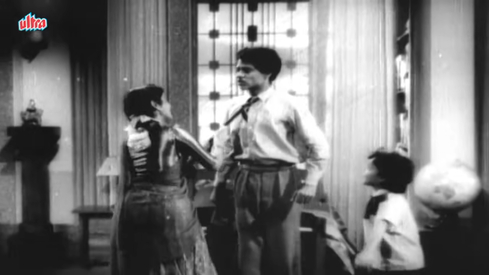
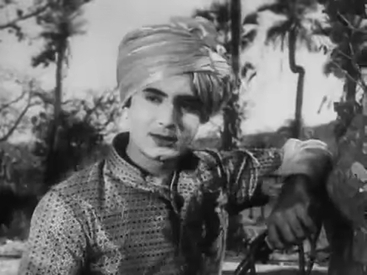
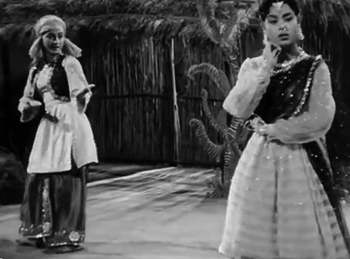
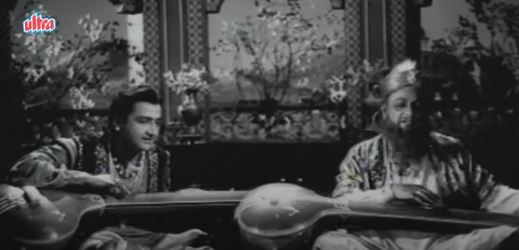
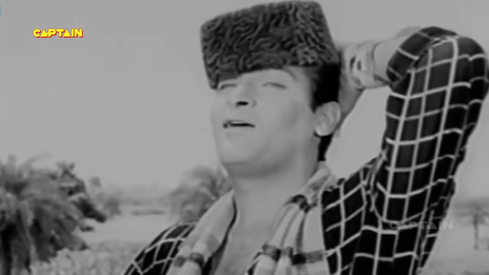
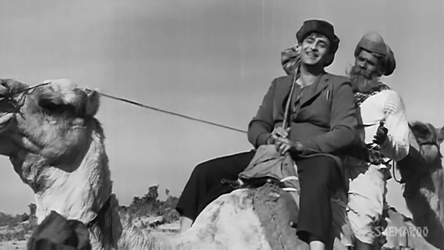
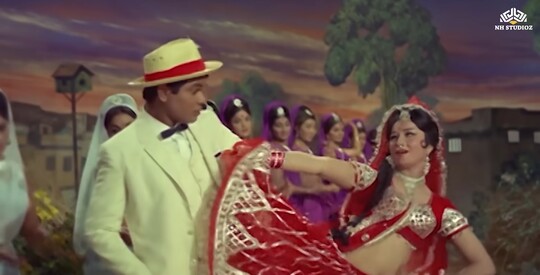
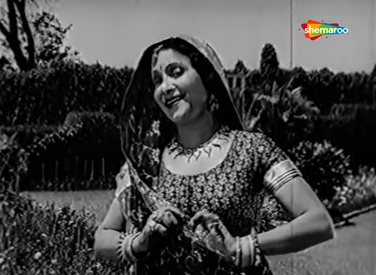
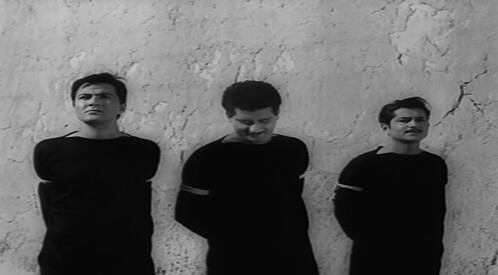
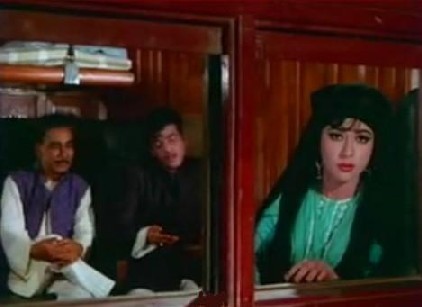
interesting
your compilations thehes are always off-beat. WELL, I SEE A BIAS TOWARDS FEMALE CLOTHING HERE
just pointing out
LikeLike
Is there a bias towards female clothing, really? Tie, cap, trousers, turban, choga – that’s five garments that are ‘traditionally’ male (though now mostly unisex). So that’s half the post.
LikeLike
no no I meant that female clothing is more elegant in ghr songs you have chosen
LikeLike
It’s so sweet of you to accept your reader’s request and then make an effort to write a piece. It’s a fun post.
I’m not thinking of new songs. Right now, just three old songs come to my mind:
Mohe panghat pe (mori saree anadi bhigoy gayo re).
Paan khaye saiyyan (haye, haye malmal ka kurta)
Chhor do aanchal zamana kya kahega (if aanchal is acceptable).
LikeLiked by 1 person
Oh, nice! Yes, there are lots of examples of clothing hidden away inside songs too. :-)
LikeLiked by 1 person
Would wearing perfume qualify under this post?
Technically, perfume is not attire but we do “wear” it, so hopefully it qualifies.
If it does, here is a song about wearing perfume.
Neki Aur Badi (1949).
Amirbai Karnatki and Feroz Dastur
Music by Roshan
Lyrics – “Kyon ji scent lagaya hai”
https://www.youtube.com/watch?v=Z3Gj3Q39S2k
LikeLiked by 1 person
No, I’m afraid that doesn’t qualify, because while you ‘wear’ it, you could also wear much else – a glum expression, for instance, or a big smile! But thank you for this song, because you’ve reminded me that I have to complete my research and writing of another song list I have in the pipeline, of songs about cosmetics. :-)
LikeLiked by 1 person
paan khaye saiyaan hamare. hai hai malmal ka kurta Malamal ke kurte pe cheent lal lal. Teesri kasam
LikeLiked by 1 person
Yes, it’s been mentioned earlier by another blog reader too. :-)
LikeLike
delightful Do one on ornaments. Jhumka. Payal. Kangana. Parijan. Nathuni. Chudi. Some lovely songs await you.
LikeLiked by 1 person
Yes, indeed, Sathya! I did a post on jewellery songs some years ago. Lots of nice songs (and if I’d done that post now, I’d probably also have added Baazuband khul-khul jaaye from Baazuband). Here’s the post; I hope you enjoy it:
https://madhulikaliddle.com/2015/07/03/ten-of-my-favourite-jewellery-songs/
LikeLike
An interesting post on clothing, both the write-up and the songs were enjoyable.
Here’s one on pagdi from Shaheed – pagdi sambhal jatta
The song is also repeated in the newer films on Bhagat Singh. Like this one from the Legend of Bhagat SIngh
LikeLiked by 1 person
Thank you for this one! Since I’d already got another turban song on the list, I had to regretfully leave this one out, but I was hoping someone would post it.
LikeLike
The 90s had an overdose of these songs on attire – especially dupatta, chunari, choli etc. Many of them featuring Govinda, Salman Khan.
The most famous being Choli ke peechhe from Khalnayak. It led to some risque ones like aanchal ke andar kya hai choli etc.
O lal dupattewali tera naam to bata – Ankhen
O hare dupattewali seedhi sadhi – Sanam Bewafa
Chunari chunari – Biwi No 1
Suit boot mein aaya kanhaiya – Kishan Kanhaiya
Meri pant bhi sexy – Dulara
Neela dupatta peela suit – Hamesha
LikeLiked by 1 person
Yes! I wonder why there was this obsession with clothing in the 1990s (and, as you point out, lots of innuendo too). All these songs used to be pretty popular, though there’s not one there that I like! Here’s another of the ghastly ones:
Main Laila Laila chillaaoonga kurta phaadke
https://www.youtube.com/watch?v=sBya2Si5JOc
LikeLike
It’s an amazing post speaking volumes of the deep research gone into its creation. On one hand, you have covered immensely popularly songs like Reshmi Salwar Kurta Jaali Ka, Sar Pe Topi Laal Haath Mein Resham Ka Roomal, Rookh Se Zara Naqab, Mera Joota Hai Jaapani and Mera Rang De Basanti Chola; on the other, you have covered many lesser known songs too. I am falling short of words to admire your effort properly.
LikeLiked by 1 person
You are very kind, Jitendraji. Thank you so much. I am so glad you enjoyed this post.
LikeLiked by 1 person
Couple of more songs on “choli”
Jaipur ki choli from Gehri Chaal
Choli ke peeche kya hai from Khal Nayak
I couldn’t embed the youtube links to these songs for some reason.
LikeLiked by 1 person
Thank you for these! I hadn’t remembered Jaipur ki choli, though of course Choli ke peechhe kya hai was very controversial back then.
LikeLike
:-) I don’t like Choli ke peeche kya hai song.
LikeLike
Yes, it’s a frightful song.
LikeLike
I wrote a comment yesterday; it seems to have gone ‘pouf’!
Would it surprise you that I had a list of ‘apparel songs’? :) Our lists overlap quite a bit; but, like you said, some of them aren’t great songs, they just fit the theme.
So here are a few that’s on my list and not on yours:
A hat:
Ae meri topi palat ke aa from Funtoosh (1956)
https://www.youtube.com/watch?v=FuuYt9OZFxM
The aanchal
Aanchal mein saja lena kaliyan from Phir Wohi Dil Laaya Hoon (1963)
https://www.youtube.com/watch?v=peJZkX35fxw
A shoe
Jiska jootha usi ka sar from Guest House (1959)
https://www.youtube.com/watch?v=CO7nsxTPQpo
Silwa de re saajanwa mohe reshmi salwar from Sindoor (1947)
https://www.youtube.com/watch?v=VgpuUgERLJc
Pyjama/kurta
Pyjama tang hain kurta dheela from Shimla Road (1969)
https://www.youtube.com/watch?v=vCUy0Um_wyM
Of course, there are much newer songs that talk about various articles of clothing. I absolutely hate Chole ke peechhe kya hain but the woman can dance and here she is with Ranbir Kapoor in a song she sings about her ghaagra. :) [Though I don’t know if you can call what they are doing, ‘dancing’.]https://www.youtube.com/watch?v=caoGNx1LF2Q
And apparently, I have been living under a rock because there is a song about the humble sari ‘fall’.
https://www.youtube.com/watch?v=EkxOXF9J77w
Hope this comment is published…
LikeLiked by 1 person
WordPress must have decided anybody who added so many URLs must be a spammer! (but then, like John Donne’s poetry, WordPress is like the peace of God: it passeth all understanding).
I am not at all surprised that you too had an apparel songs list. I love the songs you’ve listed – some there (like the one from Simla Road) were on my long list too.
And yes, I simply loathe Choli ke peechhe kya hai. Foul.
I came across that Saree fall song too, while doing research for this post! And here are two others that I found but couldn’t use, because of my self-imposed rule of posting songs only from films I’ve seen.
Pehenke nau gaz ki main saree, from Narad Leela:
https://www.youtube.com/watch?v=GZo-uSKbAgw
And Dhoti aur patloon mein ek din hui ladaayi, from Maalkin:
https://www.youtube.com/watch?app=desktop&v=2R7-P_mL9C8
LikeLike
Madhuji, this is a very innovative post!
Here are two songs – one about a jacket and the other about pallu(or pallo in the song)
Teri Neeli Neeli Jacket from Taxi Driver (1973)
https://www.youtube.com/watch?v=cGp-fAaaVM8
and Pallo latke (Naukar); here pallo refers to the odhni.
https://www.youtube.com/watch?v=Y_JUeo1wST4
Anita
LikeLike
Thank you for these songs, Anitaji! I don’t think pallo would really fit because it’s not a garment in itself – like ghoonghat, it’s a part of another garment (a saree or odhni/chunari). But Teri neeli neeli jacket is quite a find! Thank you for this one.
LikeLike
Though I am not fond of this song, its fits the bill here.
Also Lungi as an attire has not been covered yet.
Agneepath 1990 – Hum ye lungi uthati tumko disco dikhati
LikeLike
What a frightful song! But yes, the lungi fits completely into this list.
LikeLike
A shaadi wala song from the 90s covering both dupatta and joote
Hum Aapke Hai Kaun – Joote de do paise le lo
https://www.youtube.com/watch?v=cTfqLSmsxt0
LikeLiked by 1 person
Good find! Thank you for this one.
LikeLike
Just a suggestion Madhu, please give the name of singer against each song, if not lyricist and music director.
LikeLiked by 1 person
I’ll try to keep that in mind. Thank you for the suggestion. :-)
LikeLike
What an interesting post!!! First song came to my mind was ‘Reshami Salwaar’ and then ‘Pagdi sambhal jatta’. Never heard of turra before in hindi, though in marathi we use the same name.
Does ‘aanchal’ fit the theme? It’s not a separate garment per say, but important one and gets due mentions in the songs like ‘<a href=“ https://youtu.be/QUyFoyHT8s8?si=uhZ5AGOBRKqNaPZ8”>Chhod do anchal</a>, ‘Aanchal me kya jee’, ‘Aanchal me saja lena kaliyaa’, ‘<a href=“https://youtu.be/9EWXFTxllEo?si=5rxxIEgZEJjWKsmk”>Hujur is kadar</a>’ and of course pallu as in <a href= “https://youtu.be/Y_JUeo1wST4?si=_eGlZ8s4fV3VzeqE “>Pallo latke</a>
And the first cousin of pallu is ‘Ghoongat’ for ‘<a href=“https://youtu.be/cBw4H6Dx4vc?si=rzLpiVgHMsMd1ar1”>Ghoongat ki and she</a>’, ‘Ghoongat ke pat khol’, <a href=“https://youtu.be/kzTG4nejpyg?si=-lle2DWwuvmvZJV0”>Manbhavan ke ghar Jayme gori </a>
Then there is hijaab for ‘<a href=“https://youtu.be/lu_xwkVHji4?si=8bamnBu5OjD2HdqM”>Chehra chhupa Ilya hai</a>’ & <a href=“https://youtu.be/WCBkUNedgrk?si=Iy-iw_yS7V-72qhf“>Parda hai parda</a>
‘Joda’ as in wedding finery as in ‘<a href=“https://youtu.be/OspoXvv2RGM?si=hOVob78cAjhC2Tm3“>Surkh jode ki ye jagmagahat</a>’
Choli is not far behind either as in ‘dulhan chali pehan teen rang ki choli’ and when there is a saree, can fall fall behind?
<a href=“https://youtu.be/oEdI8AidKLw?si=NDT_Y-TCPxhUlEat”>Saree ke fallsa</a>
Chunaree <a href=“https://youtu.be/ROPIDnr8cJM?si=ElfIxdRTNp6i9pto”>Jaise Radhane Mala jape</a>
My comments are incomplete without marathi song so here are famous ones
<a href=“https://youtu.be/XdVUk0rMl0g?si=GG3Sg2Wd7GG3rMrI“>padarawarti jartaricha mor</a>
<a href=“https://youtu.be/Qf02VW7lDXE?si=9Xqnoi2obE2DiX_h“>Hat Naka lava mazya sadila</a>
<a href=“ https://youtu.be/piSYNyOs4Mw?si=TUkydtFZHgFchub6“>Kheltana rang bai holicha</a>
<a href=“https://youtu.be/rJA5w40yJAk?si=SWxLxgn_rr4YPA83 “>De re kanha</a>
LikeLiked by 1 person
Thank you – I’m glad you enjoyed this list, and thank you too for the many songs you suggested (some have been suggested by others too in the comments, but the Marathi songs are totally unique). Palla/pallu and ghoonghat and aanchal are not really garments, rather a particular garment pulled into a function – so I did not want to list any songs around those. :-)
LikeLike
LikeLike
The iconic Jungle Jungle baat chali hai by Gulzar Saab for the animated Jungle book, though not technically a movie, has raised the humble Chaddhi to adorable cuteness in the Indian psyche :)
LikeLiked by 1 person
How did I forget this one?! SO cute. I remember an anecdote about how the DD powers-that-be got all huffy with Gulzar for this and said it’s vulgar. So Gulzar said something around the lines of “Toh yeh behtar hoga ke bina chaddi ke phool khila hai?” :-D
They shut up after that and let it be.
LikeLike
The Suit was/is the quintessential sartorial aspiration for the average Indian to announce his ‘arrival’ in the ‘society’ and which song captures it better than this song from Sagina Mahto … Saala main toh sahab ban gaya…
LikeLiked by 1 person
Yes, this one was on my long list, though because the film is from after my blog’s cut-off period, I couldn’t use it. I was hoping someone would post it! Thank you, Anubha. I’m surprised, actually, that nobody posted this song before.
LikeLike
A lot of Holi songs have references to garments, especially to the bodice , and obviously all puns intended. A few have been mentioned earlier I think, so adding just one more (top of mind recall), Aaj na chhoddheinge bas humjoli kheleinge hum Holi, chase bheege teri chunariya, chahe bheege re choli..from the movie Kati Patang
LikeLiked by 1 person
Yes, I’d forgotten that reference! Thanks for that.
LikeLike
Unusually catchy for a relatively recent song , Guru Randhawa’s Tainu suit suit karda , raised to a visual delight by Irrfan Khan and Saba Qamar’s presence (Movie: Hindi Medium), all alliterations to the Punjabi Suit :)https://youtu.be/88LgZ-cf_P4?si=paLZcX9WPfsLawp-
LikeLiked by 1 person
I thought this one was new to me, but then realized that I have heard it, indeed. Yes, definitely catchy.
LikeLike
How come the most commonly worn female attire , the saree, does not feature among this list?
LikeLiked by 1 person
Because there seem to be very few songs featuring the saree. I did find one, Pehenke nauz gaz ki main saree, but it’s from a 1972 film (Narad Leela) beyond the time scope of this blog.
LikeLike